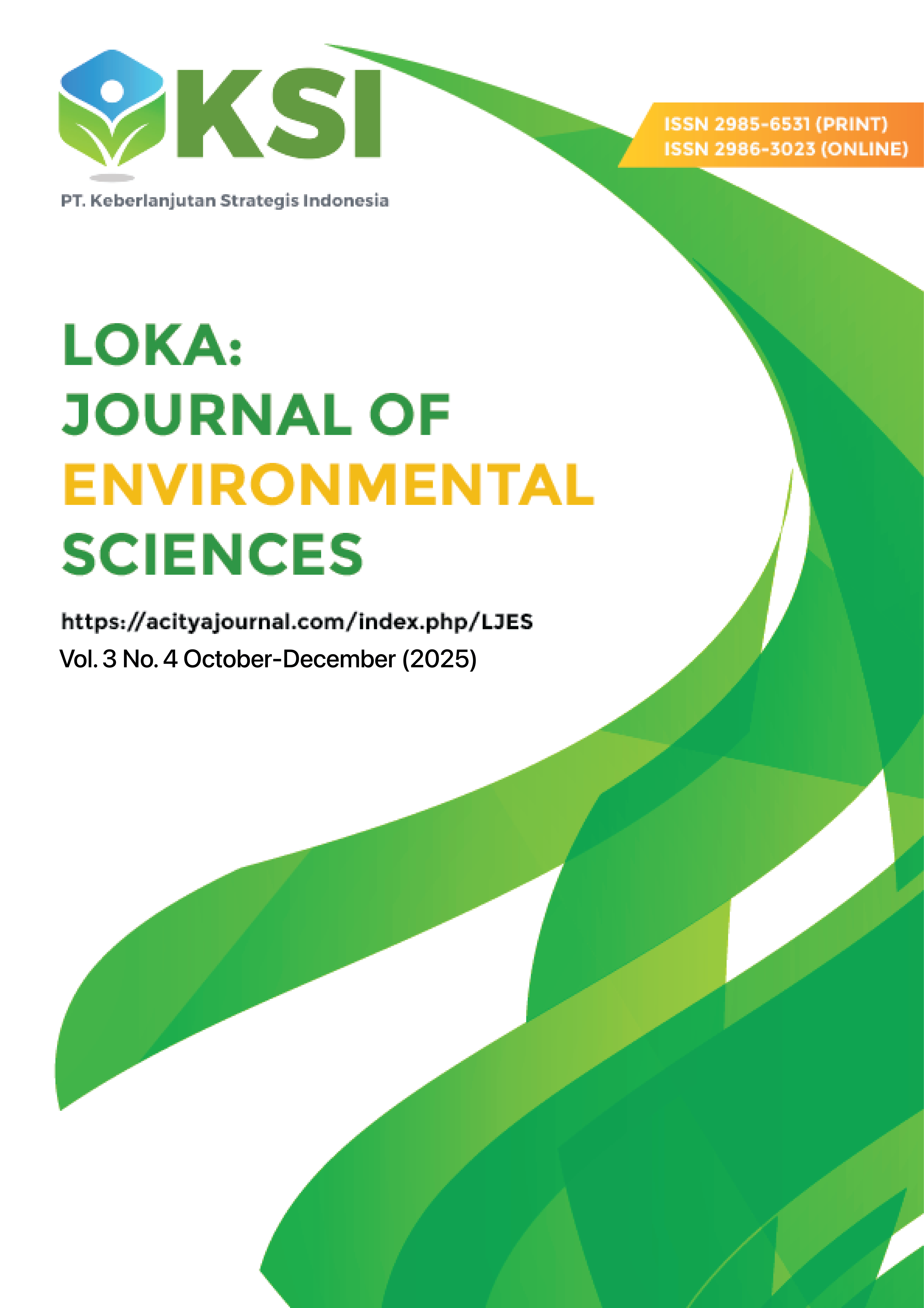Advancing Energy Transition: Solar PV and Battery Energy Storage Integration in Indonesia–South Korea Cooperation
DOI:
https://doi.org/10.38142/ljes.v2i4.353Keywords:
Solar Photovoltaic (PV), Battery Energy Storage Systems (BESS), Energy TransitionAbstract
Purpose:
This study aims to analyze Indonesia’s energy transition by modeling the integration of solar PV and Battery Energy Storage Systems (BESS) while assessing the role of Indonesia–South Korea cooperation in enhancing technological adoption, investment, and energy diplomacy.
Methodology:
This research employs a multidisciplinary approach combining quantitative mathematical modeling of solar PV–BESS integration with qualitative analysis of Indonesia–South Korea cooperation through international political economy and energy diplomacy frameworks.
Findings:
The study finds that integrating solar PV with Battery Energy Storage Systems (BESS) could significantly enhance Indonesia’s grid reliability. Mathematical modeling shows that PV–BESS integration improves grid reliability and reduces coal reliance. reduce coal dependency, while Indonesia–South Korea cooperation provides technological, financial, and diplomatic leverage to accelerate the renewable energy transition.
Implication:
The findings imply that Indonesia should expand rooftop and utility-scale solar PV with BESS to secure the electricity supply, while hybrid systems can cut fuel costs in remote areas. Collaboration with South Korea can further accelerate deployment through technology transfer and local battery production.
Downloads
References
Antara News. (2024). Looking Forward to Indonesia’s Solar Future. Retrieved from https://en.antaranews.com/news/323823/looking-forward-to-indonesias-solar-future
Boyle, G. (2012, 3rd ed.). Renewable Energy: Power for a Sustainable Future. Oxford University Press.
Bistline, J., & Blanford, G. (2021). Value of storage under policy uncertainty. Energy Economics, 99, 105–122.
BloombergNEF. (2022). Global PV Market Outlook 2022–2025. BloombergNEF.
BloombergNEF. (2023). Battery Price Survey 2023. BloombergNEF.
Climate Transparency. (2023). Brown to Green Report: Indonesia.
Denholm, P., et al. (2021). Impact of energy storage on renewable integration. Energy Policy, 149, 112–120.
Ember. (2024). Global Electricity Review 2024. Available at: [link unavailable]
ESDM (Ministry of Energy and Mineral Resources). (2021). Indonesia Energy Outlook 2021. Jakarta: ESDM.
ESDM. (2023). Handbook of Energy & Economic Statistics of Indonesia 2023. Jakarta: ESDM.
EnergyTrend. (2024). Indonesia issues new quota for rooftop solar system development. Retrieved from https://www.energytrend.com/news/20240704-47769.html
Financial Times. (2024). Hyundai and LG open Indonesia’s first EV battery cell plant. Financial Times. Retrieved from https://www.ft.com/content/b9ecf63a-596b-4dda-9445-c21669734d7c
Gilpin, R. (2001). Global Political Economy: Understanding the International Economic Order. Princeton University Press. https://doi.org/10.1515/9781400831272
Global Solar Atlas. (2023). Indonesia Solar Irradiation Data. The World Bank / ESMAP.
Government of Indonesia. (2017, updated). RUEN: Rencana Umum Energi Nasional. Kementerian ESDM/BAPPENAS.
Government of Korea. (2020). Korean Green New Deal. Ministry of Economy and Finance.
Green Climate Fund (GCF). (2022). Funding Proposal Summaries: Grid-Scale Storage in Asia.
Hittinger, E., & Azevedo, I. (2020). Bulk energy storage for grid applications. Nature Energy, 5, 1057–1064.
Hyundai Motor Group. (2023). Sustainability Report: Electrification Strategy.
International Energy Agency (IEA). (2021). The Role of Critical Minerals in Clean Energy Transitions.
IEA. (2022). Southeast Asia Energy Outlook 2022.
IEA. (2023). Electricity 2023: Analysis and forecast to 2025.
IEA. (2024). Grid-Scale Storage: Tracking Clean Energy Progress 2024.
IESR. (2022). Critical Minerals and Indonesia’s Battery Industry.
IESR. (2023). Indonesia Energy Transition Outlook 2023.
Ikäheimo, J., et al. (2020). Flexibility from storage and demand response in islanded systems. Applied Energy, 269, 115–123.
IFC. (2021). Green Buildings and Distributed Solar in Indonesia: Market Assessment.
Irena. (2020). Electricity Storage and Renewables: Costs and Markets to 2030 (Update).
International Renewable Energy Agency (IRENA). (2020). Innovation Outlook: Smart Charging for Electric Vehicles. https://www.irena.org/publications
Irena. (2022). Innovation Landscape Brief: Utility-Scale Batteries.
Irena. (2022). Renewable Power Generation Costs in 2022.
Irena. (2023). World Energy Transitions Outlook 2023.
Irena & IEA. (2022). Renewables Integration in Power Systems: Status and Lessons. Available from the joint report.
IPCC. (2022). AR6 Working Group III: Mitigation of Climate Change. Cambridge University Press.
Isaac Newton. (1687/2020). Philosophiæ Naturalis Principia Mathematica. University of California Press. https://doi.org/10.5479/sil.52126.39088015628399
JETP Secretariat. (2023). Comprehensive Investment and Policy Plan (CIPP). Retrieved from https://jetp-id.org/storage/official-jetp-cipp-2023-vshare_f_en-1700532655.pdf
KDI (Korea Development Institute). (2021). Green ODA and Energy Cooperation in ASEAN.
Kreyszig, E. (2011, 10th ed.). Advanced Engineering Mathematics. Wiley.
Lazard. (2023). Levelized Cost of Storage (LCOS) 2023 & LCOE v16. Available from Lazard.
LG Energy Solution. (2023). Annual Report & Technology Roadmap.
McKinsey. (2023). How to Power Indonesia’s Solar PV Growth Opportunities. Available at: https://www.mckinsey.com/id/our-insights/how-to-power-indonesias-solar-pv-growth-opportunities
Ministry of Trade, Industry and Energy, Korea (MOTIE). (2022). Korea Energy Policy Roadmap 2050.
Nasution, A., Harahap, F., & Santosa, D. (2022). Public perception and land use conflicts in renewable energy projects in Indonesia. Journal of Cleaner Production, 363, 132–149.
Nayak, P. K., et al. (2021). Lithium-ion battery materials for grid-scale storage: status and prospects. Joule, 5(7), 1566–1601.
Nugroho, H. (2021). Nickel and the Energy Transition in Indonesia. Indonesian Journal of Energy Policy.
OECD. (2021). Green Finance and Investment: Clean Energy Finance and Investment Policy Review of Indonesia.
OECD. (2022). Blended Finance for Energy Transition in Emerging Economies.
Oatley, T. (2019, 6th ed.). International Political Economy. Routledge. https://doi.org/10.4324/9781351034661
PLN. (2021). RUPTL 2021–2030: Rencana Usaha Penyediaan Tenaga Listrik.
Samsung SDI. (2023). ESG Report & Battery Business Overview.
Sepulveda, N. A., et al. (2021). Storage and firm low-carbon power in deep decarbonization. Joule, 5(6), 1337–1357.
Sinaga, O. P. P. Integrasi Pembangkit Listrik Tenaga Surya dan Battery Energy Storage Systems untuk Pemenuhan Energi Industri di Pulau Terpencil: Studi Kasus Pulau Bunyu Indonesia. Tesis Magister, Institut Teknologi Bandung.
Solar Magazine. (2020). Indonesia: A Nation Rich in Unrealized Solar Energy Potential. Retrieved from https://solarmagazine.com/solar-profiles/indonesia/
StraitsTimes. (2025). LG Energy pulls out of $11 billion EV battery project with Indonesia. Retrieved from https://www.straitstimes.com/business/companies-markets/lg-energy-pulls-out-of-11-billion-indonesia-ev-battery-project
The Investor. (2025). LG chief doubles down on EV battery push with Indonesia visit. Retrieved from https://www.theinvestor.co.kr/article/10505206
Tong, D., et al. (2021). Coal retirement pathways and storage needs in Asia. Nature Communications, 12, 1462.
UN ESCAP. (2021). Integrating Renewable Energy and Storage in ASEAN Grids.
UNFCCC. (2021). Indonesia NDC Update 2021.
Victoria, M., et al. (2020). Minimizing storage needs in 100 % renewable power systems. Energy, 190, 116381
World Bank. (2022). Indonesia Country Climate and Development Report (CCDR).
World Bank. (2023). Scaling Up to Phase Down: Financing Energy Transitions in Indonesia.
Zubi, G., et al. (2020). The role of battery storage in high-renewable electricity systems. Renewable & Sustainable Energy Reviews, 120, 109646. https://doi.org/10.1016/j.rser.2019.109646
Downloads
Published
Issue
Section
License
Copyright (c) 2025 Abdul Khakim Mahfud ZUBAIDI, Isya Wiradisna FAIZAL

This work is licensed under a Creative Commons Attribution-NonCommercial 4.0 International License.
Creative Commons Attribution-NonCommercial 4.0 International License.

















